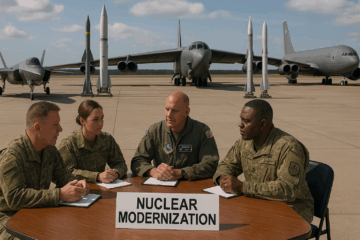As the Arctic grows warmer, so too does the potential for great power competition amongst the United States, China, and Russia. While a historic Arctic power like Russia is militarizing its waters, so-called near-Arctic China is extending its commercial reach to Greenland and Russia with the Polar Silk Road component of its Belt and Road Initiative (BRI). The United States sees both as competitors in a renewed geopolitical competition for power and influence in the High North. For now, this competition has been limited to posturing and more broadly, assertive statements of intent. However, looking forward, it may be useful to identify key national interests of the players in order to better predict potential flashpoints.
Russia – Militarization, Oil, and Gas
Russia’s approach to the Arctic is heavily informed by its geographic and historic place as an Arctic power. Fifty-three percent of Russia’s coastline is in the Arctic, which makes it a prime place to project power. Russia also has the largest population of Indigenous People in the Arctic, numbering around 1.4 million. Most importantly, however, Russia has a huge economic interest in oil and gas extraction in the Arctic as well as the further economic development of the Northern Sea Route. For Russia, then, the Arctic is a place of high stakes. Over the past few years, Russia has been steadily increasing its military and commercial presence in the Arctic, developing new bases as well as refurbishing old ones. Further, Russia is also constructing new icebreakers and submarines – some of which are nuclear powered – making it the country that likely has a distinct advantage in terms of actual military equipment.
Although Russia’s current military buildup in the Arctic is primarily defensive, some of its actions can be perceived as dually offensive and defensive. For example, in 2014, Russia established a new Strategic Command center for the Arctic both to increase Arctic security as well as to defend its interests – leading to an increase in Arctic exercises. Russia has also built more than 475 new military outputs and 16 new deep-water ports.
While this militarization might paint a very aggressive picture, it’s important to note that Russia’s interest in the Arctic also revolves around oil and gas. Much of the untapped resources in Russia’s territorial boundaries lies in the Arctic, leading the region to be extraordinarily economically important to the country. As a country that historically has prided itself on resource exports, Russia’s aggressive control over the Northern Sea Route, twenty icebreakers, and interest in the Arctic makes more sense. Regardless, Russia’s Arctic focus is certainly notable and will play an important role as the ice continues to melt, and resources become easier to access.
China: The Near-Arctic Newcomer
China plays another interesting role in the Arctic. Notably, it is not one of the Arctic Eight represented in the Arctic Council. Instead, it considers itself a near-Arctic power, joining the Arctic Council as an observer in 2013 – and in 2018 released its first white paper on Arctic Strategy. In this paper, China presented its Polar Silk Road component of its Belt and Road Initiative (BRI). Most importantly, the white paper claims that China will develop new shipping lanes that have been opened by global warming. Beyond that, China sees the development of oil, gas, fishing, and tourism as key industries to become involved in as global warming progresses.
Although China’s interest appears to be economic and commercial for now, other states do not view it as such. Former US Secretary of State Pompeo, for example, called China a threat to Arctic peace and pointed to its actions in the South China Sea as an example of what could happen in the Arctic if China’s inroads were allowed to continue. Another flashpoint between the US and China is Greenland. Recently, China attempted to buy an older naval base and build a new airport in Greenland – an effort that was halted by the US government, who allegedly has claimed they will invest in these projects instead of China. However, China is still moving forward to build investment relationships with Greenland, Iceland, and Finland concerning geothermal energy and potentially a data silk road.
Another partner in the Arctic for China may be Russia. Russia and China are increasingly working together on Arctic development, where China has been providing funding for Russian infrastructure and energy project in the Arctic. It remains to be seen whether these two powers, who arguably do not have a historically close relationship, will continue to work together moving forward.
The United States – Reactor-in-Chief
Out of the US China, and Russia, the US is likely the most reactive of the three powers. Most of its policies are in response to what it sees as unwelcome incursions of China and Russia. The American approach to the Arctic is to see the region as the next theatre in great power competition, slowly increasing its presence militarily and economically. For example, the US recently commissioned the construction of two new icebreakers. With the advent of the Biden administration, however, the US has shown a growing interest in the region. Both the US Navy and the US Department of Homeland Security released new Arctic strategies for the first time this year – illustrating the country’s renewed Arctic focus. In short, while the US is not nearly as aggressive as Russia, American rhetoric is becoming more pointed at keeping Chinese influence low and containing what it sees as Russian militarization.
While the three powers certainly are not going to head to total war anytime soon, it bears watching that rhetoric on all sides of the region is becoming more bellicose and sharper. With the new Biden administration, it will be interesting to watch the extent to which American rhetoric may change or whether temperatures and pressures will continue to rise in the Arctic.
About the Author
Gabriella Gricius is a Ph.D. student in Political Science at Colorado State University in Fort Collins, CO focusing on Russian studies, Arctic politics, and critical security theory. She also works with Dr. Wilfred Greaves at the North American and Arctic Defense and Security Network (NAADSN), focusing on human security. She is also fluent in German and Dutch and reads Russian on an intermediate level. She is also a freelance journalist and writes for a variety of online publications including Foreign Policy, Global Security Review, and Riddle Russia, amongst others.



